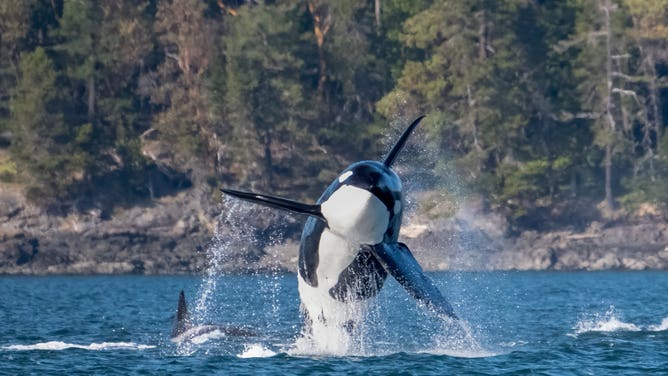Bigg's killer whale sightings near Washington, British Columbia hit new record this year
Ten years ago Bigg’s killer whale sightings were only about 15% of what they are now, according to the Pacific Whale Watch Association and Orca Behavior Institute. Meanwhile sightings of salmon-eating killer whales are trending downward.
Bigg's killer whale sightings are up near Seattle
Video shows breaching Bigg's killer whales in the Salish Sea outside of Seattle. This year was another record-breaking year for killer whale sightings throughout the Salish Sea of British Columbia and Washington State.
SEATTLE – This year, more Bigg's killer whales were seen off the coast of Washington and British Columbia than in previous years, an upward trend that has continued over the past decade, according to ecotourism and wildlife groups.
The Pacific Whale Watch Association (PCWWA) and Orca Behavior Institute (OBI) tallied the unique sightings of Bigg's, or mammal-hunting, killer whales over the past ten months in the Salish Sea, which includes Puget Sound in Washington and stretches north into Canada's British Columbia.
The groups said there were 1,270 unique sightings as of Oct. 31, surpassing 2022's total of 1,220 sightings, with still two months to go in 2023.
WATCH: SPECTACULAR UNDERWATER FOOTAGE CAPTURES ORCA 'ORCHESTRA' IN ICY ANTARCTICA WATERS
Ten years ago, killer whale sightings were 15% of where they are today, according to OBI Director Monika Wieland Shields.

A beaching male Bigg's killer whale in Western Prince. (Image: Bethany Shimasaki)
"This is the ninth year out of the last ten that the record has been broken," she said. "Only 2020 showed a slight dip, probably due to decreased observation due to Covid-19."
Wildlife organizations attribute the increasing encounters to the rebound of seals and sea lions in the Salish Sea, which comprise Bigg's killer whales' primary food source.
FISHING TRIP TURNS INTO RARE ORCA SIGHTING FOR BOATERS OFF FLORIDA COAST
"What’s happening with Bigg’s killer whales right now is truly remarkable to witness," PWWA executive director Erin Gless said. "People once referred to them as ‘transient’ killer whales because sightings were so rare, but now we’re seeing them almost daily, and we have their food to thank for that."
With the passing of the Marine Mammal Protection Act in 1972, the population of harbor seals and sea lions bounced back off the coast of Seattle and Vancouver, luring Bigg's killer whales back to the Salish Sea.
NO FLUKE: WHALE WITHOUT TAIL SPOTTED OFF CALIFORNIA COAST
Unfortunately for the region's Southern Resident killer whales, the population of killer whales that feed on Chinook salmon, their sightings continue to drop. Threatened by rising ocean temperatures, loss of habitat and pollution, the Chinook salmon have declined in recent years, according to PWWA.
Record-low numbers of Chinook salmon across California and Oregon prompted the National Marine Fisheries Service to ban salmon fishing for part of the West Coast through the spring.
With less food, the Southern Resident killer whales spend more time on the outer coast, where they can find more salmon runs.
Shields said 2023 will likely be the second-lowest year for their presence on record.




